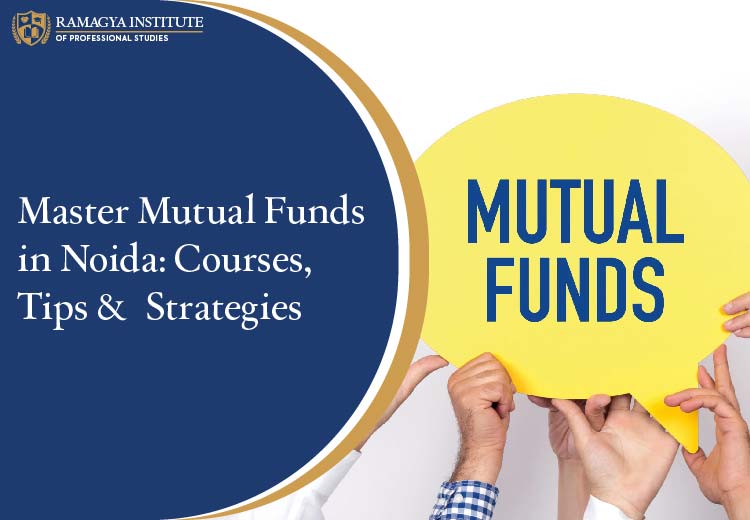Courses, Tips & Strategies
Many people wish their money could grow safely but feel unsure how. Mutual Funds are one strong way to do it. You put in some money, experts invest it, and over time your money can grow. If you want to succeed, learning well, using good habits, and choosing trustworthy guidance are very important.
In this blog, you will learn:
- What is mutual fund
- Why understand and use it
- How to learn Mutual Funds in Noida
- Good tips and smart strategies
What is a Mutual Fund?
A mutual fund is a pool of money collected from many people. That money is used to buy different investments – shares, bonds, or other financial items. Everyone who puts in money gets a share of the mutual fund. If the investments do well, you get returns; if they don’t, there’s risk.
Mutual Funds help spread risk, because money is not just in one place. A good mutual fund gives you exposure to many sectors, lowering risk of loss. Now that you know what mutual funds are, here’s why understanding them matters.
Why Learn Mutual Funds?
Understanding Mutual Funds will help you make better decisions. There are a few reasons to do this:
- There is no need to select particular bonds or stocks on your own.
- Professionals handle a variety of details like time to buy or sell a stock.
- Start with smaller amounts.
- Mutual funds, if chosen wisely, can provide steady long-term growth.
Knowing terms like NAV, risk, expense ratio, and types of funds helps you avoid bad funds and choose ones that suit you.
Learn Mutual Funds Effectively at Ramagya Institute
If you’re living in Noida and are looking to improve your knowledge about the world of mutual funds, there are excellent courses that you can join. They will teach you about mutual funds, how to make use of them, as well as the basics of global markets.
One special course is the Diploma in Mutual Funds & Global Stock Markets at Ramagya Institute. The course covers both Indian mutual funds and global stock markets. You learn:
- How mutual funds work
- How global stock markets function
- Types of mutual funds in which you can invest internationally
- How to read factsheets and how fees eat returns
- How to choose funds that are suited to your needs and goals
This course is designed for those serious about mastering mutual funds in Noida.
Ramagya Institute of Professional Studies – Learn Mutual Funds in Noida
If you’re interested in learning about mutual funds in Noida, Ramagya Institute of Professional Studies is an excellent option. Our mutual fund course provides the clear, practical knowledge of what a mutual fund is. They will teach you global and Indian market concepts side by side. This is a six month government approved course for those who want to learn how to compare funds, read fund documents, understand risk, and plan for long-term growth.
Our classes are fun, trainers explain clearly and students are provided with real life examples. If you’re trying to understand the concept of mutual funds in a clear manner, Ramagya Institute offers guidance that helps you make smart decisions not just theory but useful knowledge.
Tips & Strategies for Success
Here are useful strategies to do well with mutual funds:

- Start Small and Regular
Use SIP (Systematic Investment Plan) every month rather than putting a big amount at once. - Choose Fund Types Carefully
Equity funds (higher growth, more risk), debt funds (lower risk), balanced or hybrid funds. Pick what you can tolerate. - Mind the Costs
Look at expense ratio, entry/exit charges. High fees reduce returns. - Check Past Performance, but Wisely
Past returns aren’t guaranteed. Look for consistency, stable returns over years. - Diversify Your Funds
Don’t put all money in one type. Mix equity, debt, global, etc. - Stay Long-Term
Mutual funds tend to be better if you stay invested for years rather than trying to time ups and downs. - Review Periodically
Every 6-12 months check how your funds are performing. If one fund doesn’t match expectations or risk is too high, you may switch.
What to Look for in a Mutual Funds Course?
To select a suitable mutual funds course, be sure:
- It should clarify the basics and definition of mutual fund and its types, risks and returns.
- Trustworthy teachers who simplify things.
- Practical tasks that include studying the fund documents, comparing funds.
- Recognized certificates or credentials.
- Provide real examples and case studies for better understanding.
Mutual funds can assist you to increase your wealth in safe and smart methods. To get the benefits, you need to understand what a mutual fund is, choose the right course, follow smart strategies, and stay patient.
If you’re interested in learning about the basics of mutual funds in Noida, places such as Ramagya Institute of Professional Studies provide clear and logical learning pathways. Start small, pick wisely and keep learning so that your financial future will be better.
FAQs
Q1: What is a Mutual Fund in simple words?
It is pooled money from many people, invested by experts, so your money can grow if investments do well.
Q2: Can I lose money with mutual funds?
Yes, there is risk. The value can go down. But diversifying and staying long-term helps reduce risk.
Q3: How long should I stay invested?
At least 3-5 years is good. Longer is better to let investments handle ups and downs.
Q4: How do I pick the right mutual funds course?
Look for courses that explain basics well, teach through examples, have good teachers, and are recognized.
Q5: What is the Global Stock Markets part in the mutual funds course?
It covers funds that invest in shares outside India. Helps you understand foreign markets, currency risk, and global diversification.


